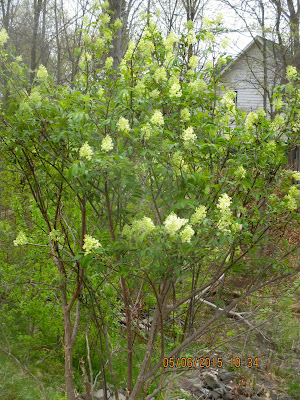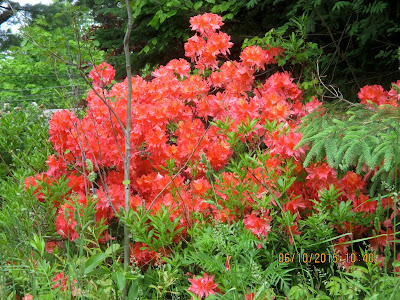 |
| WASHINGTON HAWTHORN... |
 |
| ...PANICLE OF FLOWERS |
 |
| 'PAUL'S SCARLET' HAWTHORN... |
 |
| ...ROSE-LIKE FLOWOERS |
Saturday, 6:45 AM. 65 degrees F at the ferry dock, 60 on the back porch. Wind SW, calm with light gusts. The sky is cloudy with some overcast. The humidity is 78% and the barometer is at 29.73"and bottoming out. We will likely get some rain.
Hawthorns (
Crataegus species, in the Rose Family) are interesting and useful small trees, in nature found on the edge of woods and in fence rows. Many are very floriferous and have attractive foliage and habit and can be used to good effect in the landscape. They flower after flowering crabapples, so they provide a continuation of bloom. Like crabapples, they bear attractive, small, apple-like fruit that can be quite decorative and are valuable wildlife food (edible but not very tasty).
Unfortunately, they have some drawbacks. Most are extremely thorny, some downright dangerously so. As a young man digging hawthorns by hand in the nursery I hated them, as there was no way to handle them without ending up looking like I had had and encounter with a wildcat. Nowadays equipment takes care of most of the digging, but the thorns of many species and varieties pose a danger to maintenance workers, pedestrians and children. Also, most hawthorns have a very wide branching habit, making them unfit as street trees.
Pictured are two hawthorns which have no or few thorns, beautiful flowers, and a good landscape habit. The white-flowered hawthorn is
Crataegus phanopyrum, the Washington thorn, which has glossy green leaves that are reddish in color when emerging, and red to maroon in the fall. It is resistant to fireblight, a disease which can disfigure and even kill hawthorns, crabapples, apples and other members of the rose family. It is also the last of the hawthorns to bloom, the flowers lasting as long as two weeks. Some people find the scent of the flowers very malodorous, although I don't find it objectionable.
The 'Paul's Scarlet' hawthorn is a selection of the English hawthorn,
Crataegus laevigita. Its double petalled flowers are very beautiful, looking very much like roses. It also has an upright habit, making it quite useable in the landscape. Unfortunately, this hawthorn, which was once very popular, is usually very susceptible to fireblight. The one pictured, located in a Bayfield park, has not been infected with fireblight. Unfortunately, I do not know if this individual tree has a natural immunity, or has simply not been infected.
Some hawthorns are very good for landscape use, some bad. And then there are some, like the cockspur hawthorn, with its 3," sharp thorns, which although beautiful on the edge of a woods, is just plain ugly to be around.
Hawthorns: call them the good, the bad and the ugly.
























































